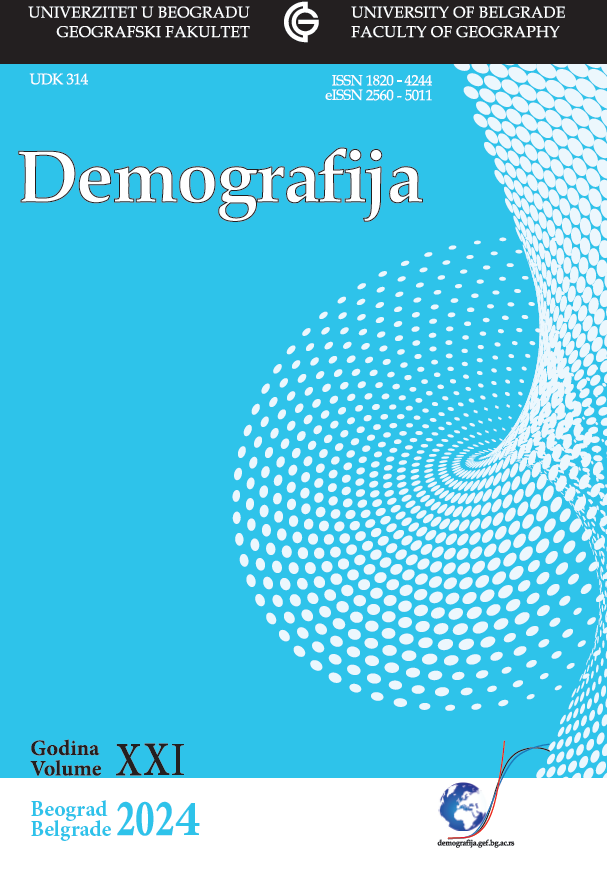URBANA REALNOST SRBIJE NA POČETKU 21. VEKA – DEMOGRAFSKI ASPEKT
THE URBAN REALITY OF SERBIA AT THE BEGINNING OF THE 21st CENTURY – DEMOGRAPHIC ASPECT
Author(s): Danica ĐurkinSubject(s): Social Sciences, Geography, Regional studies, Human Geography, Regional Geography, Sociology, Demography and human biology, Rural and urban sociology
Published by: Географски факултет, Универзитет у Београду
Keywords: urban shrinkage; urban population; Serbia
Summary/Abstract: The development and transformation of urban areas result from several geospace elements, including demographic, economic, social, infrastructural, functional, ecological, etc. The complex and synchronized effect of these elements reflects differently and leads to differences in urban dynamics and varieties of cities according to the trajectory, dynamics, and intensity of urban development. In the late 20th and early 21st century urban shrinkage has spread from developed to developing countries. Despite the world’s population growth, this „silent” process has become a universal phenomenon, affecting countries across the globe, including Serbia. The trajectory of urban development on the territory of Serbia from 1961 to 2022 shows the direction towards urban shrinkage, which has roots for several decades The appearance of the first shrinking cities dates back to the 1960s and 1970s of the last century, although their number was negligibly small then. Since the 1990s, the previous „traces“ of urban decline have become increasingly visible. Since then, a continuous decline in the urban population, the spatial expansion of the number of cities in decline, and the intensification of the process of urban population reduction have been observed. As a result of the continuous evolution of the urban population’s trajectory towards decline, at the turn of the 20th to the 21st century, the number of cities in decline doubled (1991-2002 - 37.1%). At the beginning of the new millennium, the trajectory of the urban population in Serbia takes on a new dimension. While growing cities are becoming, like shadows, a rare phenomenon in the network of urban centers, most are decreasing, and shrinking cities do not bypass any part of the country (2002-2011 - 63.9%). The inevitable negative demographic trends deepen the spatial-demographic gap and intensify the dynamics of urban shrinkage, which has reached 86.2% of urban settlements. Therefore, this phenomenon is becoming the urban reality of Serbia in the 21st century. By looking at the main demographic trends of the urban area of Serbia and monitoring the average annual rate of change of the urban population, it was possible to distinguish four trajectories of urban development - urban growth, stagnation, potential shrinkage and urban shrinkage. If we exclude Belgrade and Novi Sad, populationally, economically, and functionally the most important centers in Serbia and urban settlements in their immediate vicinity, almost three-quarters of urban settlements are shrinking. Certain spatial-economic and other factors permeate the spread and intensification of the dynamics of shrinkage. The dynamics of urban population decline determine cities with mild, moderate and strong urban shrinkage. Based on previous research (Živanović et al., 2021; Antonić, 2022; Djurkin et al., 2021; Djurkin et al., 2023; Miljanović et. al., 2023), these results show that the most affected cities are near the state border, less accessible parts of the country, more traffic-isolated, far from regional centers, insufficiently functionally developed, or characterized by a smaller population and a collapsed urban economy and backwardness. Our findings, however, also reveal the complex nature of urban shrinkage in Serbia. The shrinkage intensity in all groups (cities with mild, moderate, and strong shrinkage) represents a collage of local and regional specificities. Thus, the diversity of Serbian cities requires a regional approach to study. Given the demographic circumstances and the growing gap between „nonshrinking“ and shrinking Serbia, the question arises whether urban shrinkage is the inevitable fate of all cities and whether we will still face urban islands of growth in the shrinking sea in the future? Compared to many other countries, the issue of urban shrinkage in Serbia is mainly unrecognized by the public. Some of the most significant planning documents and development strategies, with an emphasis on demographic aspects of development (e.g. Spatial Plan of the Republic of Serbia 2021-2035, Strategy for Sustainable and Integral Urban Development of the Republic of Serbia until 2030, Strategy for Encouraging Birth, Strategy on economic migrations for the period 2021–2027, etc.) do not recognize the phenomenon of urban shrinkage, but the population decline and related demographic problems (such as emigration, aging, negative fertility rates, etc.), the proposed steps in the solution mostly bring for the territory of the entire country (Ministry of Family Care and Demography, 2018; Ministry of Labour, Employment, Veterans and Social Affairs, 2010; Ministry of Construction, Transport and Infrastructure, 2018 and 2021). Considering the trajectory of the urban population directed towards shrinkage, multidecade low birth rates, high emigration rate, and the number of shrinking cities, the obtained results are significant as a starting point for the formulation of appropriate urban development policies, demographic policies, and management strategies for different types of shrinking cities from demographic aspect. Future research will be aimed at a more precise and comprehensive determination of the factors differentiating shrinking cities (modeling of economic, social, functional, and other factors) to shed more light on the differences in the intensity of urban shrinkage.
Journal: Demografija
- Issue Year: 2024
- Issue No: 21
- Page Range: 25-52
- Page Count: 27
- Language: English, Serbian

